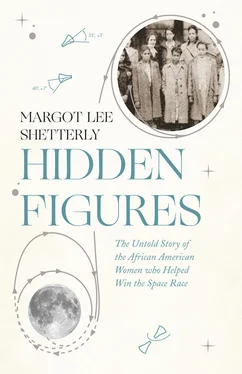My father, growing up during segregation, experienced a different reality. “Become a physical education teacher,” my grandfather said in 1962 to his eighteen-year-old son, who was hell-bent on studying electrical engineering at historically black Norfolk State College.
In those days, college-educated African Americans with book smarts and common sense put their chips on teaching jobs or sought work at the post office. But my father, who built his first rocket in junior high metal shop class following the Sputnik launch in 1957, defied my grandfather and plunged full steam ahead into engineering. Of course, my grandfather’s fears that it would be difficult for a black man to break into engineering weren’t unfounded. As late as 1970, just 1 percent of all American engineers were black—a number that doubled to a whopping 2 percent by 1984. Still, the federal government was the most reliable employer of African Americans in the sciences and technology: in 1984, 8.4 percent of NASA’s engineers were black.
NASA’s African American employees learned to navigate their way through the space agency’s engineering culture, and their successes in turn afforded their children previously unimaginable access to American society. Growing up with white friends and attending integrated schools, I took much of the groundwork they’d laid for granted.
Every day I watched my father put on a suit and back out of the driveway to make the twenty-minute drive to Building 1236, demanding the best from himself in order to give his best to the space program and to his family. Working at Langley, my father secured my family’s place in the comfortable middle class, and Langley became one of the anchors of our social life. Every summer, my siblings and I saved our allowances to buy tickets to ride ponies at the annual NASA carnival. Year after year, I confided my Christmas wish list to the NASA Santa at the Langley children’s Christmas party. For years, Ben, Lauren, and my youngest sister, Jocelyn, still a toddler, sat in the bleachers of the Langley Activities Building on Thursday nights, rooting for my dad and his “NBA” (NASA Basketball Association) team, the Stars. I was as much a product of NASA as the Moon landing.
The spark of curiosity soon became an all-consuming fire. I peppered my father with questions about his early days at Langley during the mid-1960s, questions I’d never asked before. The following Sunday I interviewed Mrs. Land about the early days of Langley’s computing pool, when part of her job responsibility was knowing which bathroom was marked for “colored” employees. And less than a week later I was sitting on the couch in Katherine Johnson’s living room, under a framed American flag that had been to the Moon, listening to a ninety-three-year-old with a memory sharper than mine recall segregated buses, years of teaching and raising a family, and working out the trajectory for John Glenn’s spaceflight. I listened to Christine Darden’s stories of long years spent as a data analyst, waiting for the chance to prove herself as an engineer.
Even as a professional in an integrated world, I had been the only black woman in enough drawing rooms and boardrooms to have an inkling of the chutzpah it took for an African American woman in a segregated southern workplace to tell her bosses she was sure her calculations would put a man on the Moon. These women’s paths set the stage for mine; immersing myself in their stories helped me understand my own.
Even if the tale had begun and ended with the first five black women who went to work at Langley’s segregated west side in May 1943—the women later known as the “West Computers”—I still would have committed myself to recording the facts and circumstances of their lives. Just as islands—isolated places with unique, rich biodiversity—have relevance for the ecosystems everywhere, so does studying seemingly isolated or overlooked people and events from the past turn up unexpected connections and insights to modern life. The idea that black women had been recruited to work as mathematicians at the NASA installation in the South during the days of segregation defies our expectations and challenges much of what we think we know about American history. It’s a great story, and that alone makes it worth telling.
In the early stages of researching this book, I shared details of what I had found with experts on the history of the space agency. To a person they encouraged what they viewed as a valuable addition to the body of knowledge, though some questioned the magnitude of the story.
“How many women are we talking about? Five or six?”
I had known more than that number just growing up in Hampton, but even I was surprised at how the numbers kept adding up. These women showed up in photos and phone books, in sources both expected and unusual. A mention of a Langley job in an engagement announcement in the Norfolk Journal and Guide. A handful of names from the daughter of one of the first West Computers. A 1951 memo from the Langley personnel officer reporting on the numbers and status of its black employees, which unexpectedly made reference to one black woman who was a “GS-9 Research Scientist.” I discovered one 1945 personnel document describing a beehive of mathematical activity in an office in a new building on Langley’s west side, staffed by twenty-five black women coaxing numbers out of calculators on a twenty-four-hour schedule, overseen by three black shift supervisors who reported to two white head computers. Even as I write the final words of this book, I’m still doing the numbers. I can put names to almost fifty black women who worked as computers, mathematicians, engineers, or scientists at the Langley Memorial Aeronautical Laboratory from 1943 through 1980, and my intuition is that twenty more names can be shaken loose from the archives with more research.
And while the black women are the most hidden of the mathematicians who worked at the NACA, the National Advisory Committee for Aeronautics, and later at NASA, they were not sitting alone in the shadows: the white women who made up the majority of Langley’s computing workforce over the years have hardly been recognized for their contributions to the agency’s long-term success. Virginia Biggins worked the Langley beat for the Daily Press newspaper, covering the space program starting in 1958. “Everyone said, ‘This is a scientist, this is an engineer,’ and it was always a man,” she said in a 1990 panel on Langley’s human computers. She never got to meet any of the women. “I just assumed they were all secretaries,” she said. Five white women joined Langley’s first computing pool in 1935, and by 1946, four hundred “girls” had already been trained as aeronautical foot soldiers. Historian Beverly Golemba, in a 1994 study, estimated that Langley had employed “several hundred” women as human computers. On the tail end of the research for Hidden Figures, I can now see how that number might top one thousand.
To a first-time author with no background as a historian, the stakes involved in writing about a topic that was virtually absent from the history books felt high. I’m sensitive to the cognitive dissonance conjured by the phrase “black female mathematicians at NASA.” From the beginning, I knew that I would have to apply the same kind of analytical reasoning to my research that these women applied to theirs. Because as exciting as it was to discover name after name, finding out who they were was just the first step. The real challenge was to document their work. Even more than the surprisingly large numbers of black and white women who had been hiding in a profession seen as universally white and male, the body of work they left behind was a revelation.
There was Dorothy Hoover, working for Robert T. Jones in 1946 and publishing theoretical research on his famed triangle-shaped delta wings in 1951. There was Dorothy Vaughan, working with the white “East Computers” to write a textbook on algebraic methods for the mechanical calculating machines that were their constant companions. There was Mary Jackson, defending her analysis against John Becker, one of the world’s top aerodynamicists. There was Katherine Coleman Goble Johnson, describing the orbital trajectory of John Glenn’s flight, the math in her trailblazing 1959 report as elegant and precise and grand as a symphony. There was Marge Hannah, the white computer who served as the black women’s first boss, coauthoring a report with Sam Katzoff, who became the laboratory’s chief scientist. There was Doris Cohen, setting the bar for them all with her first research report—the NACA’s first female author—back in 1941.
Читать дальше












